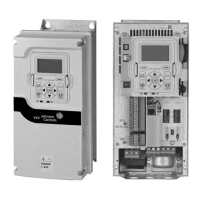29
Chapter 5—Basic application
VARIABLE SPEED DRIVE SERIES III LIT-12012999—June 2018 www.johnsoncontrols.com
Chapter 5—Basic application
The Basic Application is designed for preloaded application
sets for use with HVAC specific terminology and functions.
It has the patent Active Energy Control algorithm that will
improve your efficiency as well as minimize losses in your
motor throughout the defined speed range. It provides
the ability for the user to define its Hand and Auto control
and reference signals with the standard Off condition as
well. In addition there is the ability to scale the analog input
and output signals to be read based off the desired motor
response. There are also 8 digital inputs, 3 relay outputs,
and 1 digital output that can be programmed to allow for
control schemes that require the drive to have certain
functions. It provides full customization on the motor control
sequence with the ability to be in frequency or speed
control mode, and tuning of the V/Hz curve can be selected.
Drive/Motor protections can be customized to defined
actions for added user control. Below is a list of other
features that are available in the Basic Application.
Basic Application includes functions:
•
Bypass Control
•
Fire Mode
•
Pre heat/cold weather mode
•
Hand/Off/Auto in individual button for easy change of
control mode.
•
Programmable Protections
•
Programmable digital/analog input/output function
•
Programmable start/stop signal logic
•
Voltage and Current limiters
•
Energy Savings Calculator
•
Two independent set of Acceleration/Deceleration ramps
•
Skip frequency
•
Start source (Local/Remote control function)
•
Reference source
•
Flying start
•
Volts per Hertz control programmable
•
Real time clock—RTC time display
•
Auto restart on fault to drive or bypass
•
Programmable switching frequency
•
Multi-Preset speeds
•
Fan control
•
DC brake
I/O controls
•
Terminal To Function (TTF) Programming
The design behind the programming of the digital
inputs in the VS3 drive is to use “Terminal To Function”
programming, which is composed of multiple functions
that get assigned a digital input to that function. The
parameters in the drive are set up with specific functions
and by defining the digital input and slot in some cases,
depending on which options are available. For use of the
drives control board inputs, they will be referred to as
DigIN:1 through DigIN:8. When additional option cards
are used, they will be defined as DigIN:X:IOY:Z. The X
indicates the slot that the card is being installed in, which
will be either A or B. The IOY determines the type of card
it is, which would be IO1 or IO5. The Z indicates which
input is being used on that available option card.
•
Function To Terminal (FTT) Programming
The design behind the programming of the relay outputs
and digital output in the VS3 drive is to use “Function To
Terminal” programming. It is composed of a terminal,
be it a relay output or a digital output, that is assigned
a parameter. Within that parameter, it has different
functions that can be set.
The parameters of the Standard Application are
explained in Appendix A of this manual, “Description
of Parameters.”
The explanations are arranged according to the
parameter number. For the DI function, we use Terminal
programming method to function (TTF), where there is a
fixed input that gets programmed to a list of functions.
This allows for multiple inputs to be used for different
functions. Connecting a certain input with a certain
parameter function is done by give a parameter an
appropriate value. The value is formed by the location of
the input, either being on the standard control board or
an external option board and the slot it is located in.

